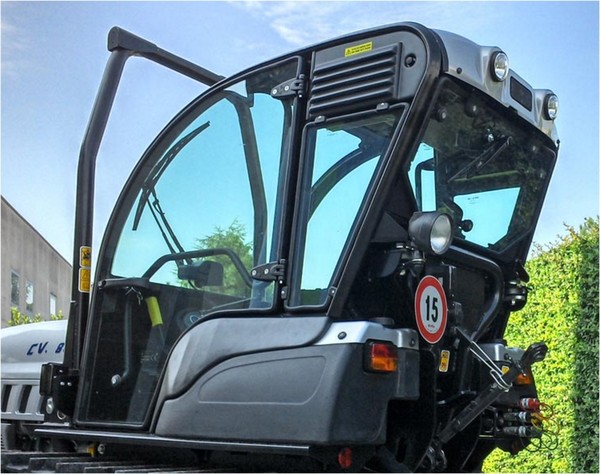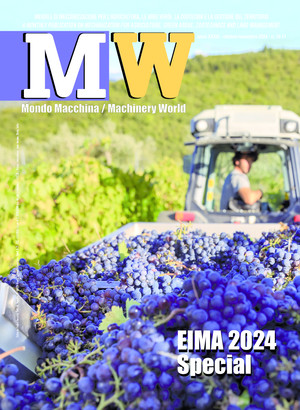
After-market cabs: a safety issue
The cabs devoted to the weather protection only are often fitted on agricultural tractors in addition to front or rear 2-pillars frames homologated as ROPS. Now the matter is to ascertain the eligibility of these cabs to maintain an effective driver safety
The main danger of a serious or fatal accident in agriculture has always been the overturning of the tractor. The problem has been tackled since the 50s of the last century. After an initial period, during which attempts were made to develop some active remedies (ie aimed at avoiding the occurrence of the incident), researchers soon passed to a “passive” concept, for which the solution is not to avoid overturning but to minimize its consequences on the driver. This is, basically, the same as the air-bags installed on cars which do not intervene to prevent the impact but reduce the negative effects of the driver and any other possible passengers.
Borrowed from earth-moving vehicles, the concept of passive protection spread rapidly even in the agricultural sector and is still the only one concretely applied worldwide. Basically, around the (or in the immediate vicinity of) the driver’s seat, is installed a roll-over protection structure (in English: ROPS, Rolling Over Protective Structure)), able toprotect the operator, thanks to the preservation of a certain volume (defined, depending on the case,“safety zone” or “deflection limiting volume, DLV”) defined with reference to the seat and the steering wheel on the tractor. Naturally, in such a scenario, protection is effective only if during the overturning the driver remains on the seat and is not thrown outwards (ending up being hit and/or crushed right by the tractor). Therefore, a complementary and indispensable element that must be installed together with the ROPS is a safety belt, usually an abdominal type, i.e. two points of attack, quite similar to that used on scheduled aircraft. Of course, this safety belt must be regularly worn, otherwise, the protective effect is completely frustrated. All conventional tractors sold in Italy after the 1.1.1974 must be provided with a ROPS. Only several years later (unfortunately...), the obligation to mount the abdominal seatbelt was enshrined. Today the situation is now stabilized: if you ask the farmers (and in general the operators of the sector), what is the most important safety requirement for tractors, they will invariably answer that it is the ROPS. In other words, the obligation (and the importance) of assembling a protection structure, certified with appropriate tests (carried out on a production prototype), is well understood and rooted. However, the issue can not be said to be completely resolved.
Types of ROPS
ROPS are not all the same: depending on the class of power, the equipment, the climate where the machines will be used, the manoeuvring spaces, the encumbrances, etc. it is possible to install either simple front or rear roll-bars on the driver’s seat, or a four-post chassis, or a closed, suspended, soundproof and air-conditioned cab. n the latter case the situation is optimal from all the points of view listed, but it is quite clear that if a simple roll-bar is installed, no weather protection is guaranteed.
After-market cabs
For this reason, in order to offer protection from the elements and to create a comfortable microclimate for the operator, in Italy several manufacturers, have for some time, started to build “after market” cab models (more correctly defined as “Protection Structures” from Weather Agents, SPAGAT), as they are installed after the purchase of the new tractor, in addition to the present ROPS. Precisely because the latter is the element capable of offering the protection required by the regulations, in the event of a tractor overturning, according to the cabs manufacturers their products don’t need to certify the necessary robustness. Therefore, over the years the the most widespread solution was to install a cab that would only provide weather protection, but that was not subjected to the type approval tests necessary to qualify it as ROPS. This solution proved to be extremely useful also for the so-called “retrofitting” namely to improve the driver comfort on tractors originally purchased (and possibly maintained for several years) only with the roll-bars. There have never been any precise statistics of how many tractors in Italy are equipped with this type of equipment, but it is estimated that there can be several tens of thousands, up to 50 thousand, taking into account, on the one hand, a long period, or about 40 years of such modus operandi, and on the other hand an inevitable scrapping rate of the tractor park, some of which are equipped with after-market cabins.
Increase the level of safety
In these last decades, different technical solutions have therefore been developed, but they must be classified in a very different way according to the regulatory requirements. Two basic case studies can be distinguished: After-market cab ROPS certified, and installed to replace the roll-bar (front or rear) or of the original chassis; After-market cab mounted in addition to the original chassis. The first solution fully complies with the rules, the latter, instead, has long been a sort of grey area to which attention has recently been paid, in order to increase the effective degree of security of the operator who works on machinery set up with the above-mentioned modalities. On the specific request of the Bodies involved in the control of the agricultural machinery for the purposes of its safety, is the SPRESAL ( Offices for safety in workplace environment, Agencies for Health Protection ATS) The National Institute for Insurance against Accidents at Work (INAIL) has set up a National Working Group (WG), which includes the various stakeholdersof the sector, in order to examine the issue in detail and put forward technical solutions to increase the safety level of the after-market cabs fitted in addition to the original ROPS.
The technical concept
Basically, it is about developing a test methodology aimed at ascertaining the suitability of the after-market cabs, in the event of overturning, to preserve the integrity of the safety zone protected by the installed ROPS. More specifically, it must be verified if, under certain stresses, no part of the after-market cab can invade the safety volume, thus avoiding any danger of interference of some of its part or component with the driver (assumed fixed to the driving position, because secured with the regularly fastened lap belt), source of potential, even serious injuries, and, at worst, fatal. The technical assumption from which the GdL started was to consider the after-market cab as an element of completion of the original ROPS able to offer a greater level of protection to the driver. Its structure was then assimilated to what the specific regulations define in English “hard fixture”, translated into Italian as “hard point”, ie elements of a certain resistance able to increase (or at least not decrease) the free space guaranteed around the driver’s seat in the event of a roll-over. In this specific case, it was adopted as safety volume the one already identified in the INAIL guidelines or the construction and assembly of protective chassis on the so-called “used tractors”, sold before the installation requirement, or on those that, for any reason, do not have it anymore. Specifically, depending on the location (front or rear of the driver’s seat) it is possible to identify the so-called “ground plane”, ie the surface on which the tractor (with its roll-bar) would lean over for a 180 ° overturning. With reference to the safety zone to be considered in accordance with the ROPS fitted, the after-market cabin must be subjected to certain loads in order to verify full compliance with the safety volume.
It is patently obvious that, with such premises, a key role is played by the energies to be absorbed or the forces to be applied to the after-market cab under test. These methods have not been completely defined at the moment but taking into account that the most common overturning types are the lateral and the rear, it seems more than justifiable to prepare two loads which ensure the after-market cab robustness in such occurrences.
In a similar way, as is the case for the ROPS test to be installed on new factory tractors, it is therefore correct to provide two loads, one rear (from back to front) and one side, to be applied to recreate the worst condition, ie on the weaker side of the after-market cab. The loads must be applied in an “almost” static way, using a hydraulic cylinder fitted with a suitable thrust plate. In greater detail, the rear load will most likely have to be applied to the rear top of the SPAGAT, from top to bottom with an inclination of 40° to the horizontal, while the side one must always be applied to the top of the cab but will have horizontal direction.
The minimum requirements will correspond, depending on the case, to a certain force to bear (for the rear load) or to a certain amount of energy to be absorbed (for the side), calculated in the latter case as the area below (that is, the integral) of the load-deformation curve. The eligibility requirement of the after-market cab will, therefore, be to fully comply with the default safety volume, i.e. none of its constructive elements will have to invade it during or after the execution of the tests. The entire procedure described will be contained in a technical standard of national validity and must be prepared by the Working Group GL 12 “Tractors” of the CUNA, launching, at the same time as it is used in these cases, a Preliminary Public Inquiry UNI.








